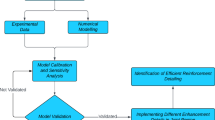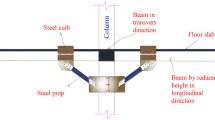Abstract
Although some of the previous plastic hinge relocation (PHR) techniques contribute to enhancing the seismic performance of beam–column joints, they suffer from a serious limitation regarding the reduction of the shear span and related failure mode. This has not been clearly addressed in the literature. So, the present study first examines the challenges of using the classic 90° hooked bar (CHB) method as a representative of other similar techniques such as U-shaped, straight, and headed bar methods. To address the challenges of relocating the plastic hinge (PH), an improved PHR technique is then introduced and studied experimentally and numerically. To do this, four large-scale self-consolidating exterior RC beam–column joints (BCJs) were tested under lateral cyclic loading up to 8% drift ratio, simulating severe earthquakes. The test specimens were comprised of a seismically designed BCJ (without PHR) and three BCJs with two different PHR techniques including (1) the CHB method and (2) the improved technique which was a combination of the CHB method with crossed inclined bars (60° and 30°) in the relocated PH. According to the test results, the use of the CHB method alone led to a significant degradation in the ductility and drift capacity due to sliding shear failure, while the improved technique effectively controlled sliding shear deformations and enhanced the ductility, energy dissipation, and load-carrying capacity. It also reduced the damage severity and prevented the crushing of the core concrete at the PH zone. Finally, some design recommendations are presented based on numerical analysis results.





















Similar content being viewed by others
References
352 A-AC (2002) Recommendations for design of beam-column joints in monolithic reinforced concrete structures. American Concrete Institute, Farmington Hills
A615/A615M-16 A (2016) Standard specification for deformed and plain carbon-steel bars for concrete reinforcement
Abdel-Fattah B, Wight JK (1987) Study of moving beam plastic hinging zones for earthquake-resistant design of reinforced concrete buildings. ACI Struct J 84:31–39
ACI (2014) ACI 318-14: building code requirements for structural concrete and commentary
ACI Committee (2005) Acceptance criteria for moment frames based on structural testing and commentary (ACI 374.1–05)
Adibi M, Marefat MS, Esmaeily A et al (2017) Seismic retrofit of external concrete beam-column joints reinforced by plain bars using steel angles prestressed by cross ties. Eng Struct 148:813–828
Adibi M, Marefat MS, Allahvirdizadeh R (2018) Nonlinear modeling of cyclic response of RC beam–column joints reinforced by plain bars. Bull Earthq Eng 16:5529–5556
Asazu N, Unjoh S, Hoshikuma J, Kondoh M (2001) Plastic hinge length of reinforced concrete columns based on the buckling characteristics of longitudinal reinforcement. Doboku Gakkai Ronbunshu 2001:177–194
ASCE, SEI 41–17 (2017) Seismic evaluation and retrofit of existing buildings, ASCE/SEI 4. American Society of Civil Engineers, Reston
ASTM A (2008) ASTM C496/C496M-04e1 standard test method for splitting tensile strength of cylindrical concrete specimens. Annu B ASTM Stand 2008 Sect 4
ASTM C39/C39M (2010) Standard test method for compressive strength of cylindrical concrete specimens
Bull IN (1978) The shear strength of relocated plastic hinges. University of Canterbury, New Zealand
Chutarat N, Aboutaha RS (2003) Cyclic response of exterior reinforced concrete beam-column joints reinforced with headed bars? Experimental investigation. ACI Struct J 100:259–264
Code M (1993) CEB-FIP model code 1990
Dalalbashi A, Eslami A, Ronagh HR (2012) Plastic hinge relocation in RC joints as an alternative method of retrofitting using FRP. Compos Struct 94:2433–2439. https://doi.org/10.1016/j.compstruct.2012.02.016
Del Vecchio C, Di Ludovico M, Balsamo A et al (2014) Experimental investigation of exterior RC beam-column joints retrofitted with FRP systems. J Compos Constr 18:4014002
Del Vecchio C, Kwon O, Di Sarno L, Prota A (2015) Accuracy of nonlinear static procedures for the seismic assessment of shear critical structures. Earthq Eng Struct Dyn 44:1581–1600
Del Vecchio C, Di Ludovico M, Prota A, Manfredi G (2016) Modelling beam-column joints and FRP strengthening in the seismic performance assessment of RC existing frames. Compos Struct 142:107–116
Del Vecchio C, Di Ludovico M, Balsamo A, Prota A (2018) Seismic retrofit of real beam-column joints using fiber-reinforced cement composites. J Struct Eng 144:4018026
Di Sarno L, Del Vecchio C, Maddaloni G, Prota A (2017) Experimental response of an existing RC bridge with smooth bars and preliminary numerical simulations. Eng Struct 136:355–368
Duan H, Hueste MBD (2012) Seismic performance of a reinforced concrete frame building in China. Eng Struct 41:77–89
Eligehausen R, Popov EP, Bertero VV (1982) Local bond stress-slip relationships of deformed bars under generalized excitations. In: Proceedings of the 7th European conference on earthquake engineering vol 4, pp 69–80
Elmenshawi A, Brown T, El-Metwally S (2012) Plastic hinge length considering shear reversal in reinforced concrete elements. J Earthq Eng 16:188–210
Eom T, Park H, Asce AM et al (2015) Plastic hinge relocation methods for emulative pc beam—column connections. Am Soc Civ Eng 04015111:1–13. https://doi.org/10.1061/(ASCE)ST.1943-541X.0001378
FEMA 356 BSSC (2000) FEMA 356-prestandard and commentary for the seismic rehabilitation of buildings. Federal Emergency Management Agency, Washington, DC
Galunic B, Bertero VV, Popov EP (1977) An approach for improving seismic behavior of reinforced concrete interior joints. University of California, California
Ghobarah A (2004) On drift limits associated with different damage levels. In: International workshop on performance-based seismic design. Department of Civil Engineering, McMaster University, June 28–July 1
Ghobarah A, Said A (2002) Shear strengthening of beam-column joints. Eng Struct 24:881–888
Greifenhagen C, Lestuzzi P (2005) Static cyclic tests on lightly reinforced concrete shear walls. Eng Struct 27:1703–1712
Hoshikuma J, Kawashima K, Nagaya K, Taylor AW (1997) Stress-strain model for confined reinforced concrete in bridge piers. J Struct Eng 123:624–633
Hwang H-J, Eom T-S, Park H-G (2015) Design considerations for interior RC beam–column joint with additional bars. Eng Struct 98:1–13
Ilia E, Mostofinejad D (2019) Seismic retrofit of reinforced concrete strong beam–weak column joints using EBROG method combined with CFRP anchorage system. Eng Struct 194:300–319
Joh O, Goto Y, Shibata T (1991) Influence of transverse joint and beam reinforcement and relocation of plastic Hinge region on beam column joint stiffness deterioration, vol 123. ACI Spec Publ, Detroit
Kanchanadevi A, Ramanjaneyulu K (2019) Non-invasive hybrid retrofit for seismic damage mitigation of gravity load designed exterior beam–column sub-assemblage. J Earthq Eng 23:1–26
Karayannis CG, Chalioris CE, Sirkelis GM (2008) Local retrofit of exterior RC beam–column joints using thin RC jackets—an experimental study. Earthq Eng Struct Dyn 37:727–746
Kotsovou G, Mouzakis H (2012) Exterior RC beam-column joints: new design approach. Eng Struct 41:307–319. https://doi.org/10.1016/j.engstruct.2012.03.049
Kupfer H, Hilsdorf HK, Rusch H (1969) Behavior of concrete under biaxial stresses. In: Journal proceedings, pp 656–666
Lee S-C, Cho J-Y, Vecchio FJ (2011) Model for post-yield tension stiffening and rebar rupture in concrete members. Eng Struct 33:1723–1733
Lima C, Martinelli E, Faella C (2012) Capacity models for shear strength of exterior joints in RC frames: experimental assessment and recalibration. Bull Earthq Eng 10:985–1007. https://doi.org/10.1007/s10518-012-9342-2
Moehle JP (2015) Seismic design of reinforced concrete buildings. McGraw-Hill Education, New York
Montoya E, Vecchio FJ, Sheikh SA (2006) Compression field modeling of confined concrete: constitutive models. J Mater Civ Eng 18:510–517
Oudah F, El-Hacha R (2017a) Plastic hinge relocation in concrete structures using the double-slotted-beam system. Bull Earthq Eng 15:2173–2199
Oudah F, El-Hacha R (2017b) Seismic performance of modified single-slotted-beam concrete connection. J Earthq Eng 21:726–751
Palermo D, Vecchio FJ (2003) Compression field modeling of reinforced concrete subjected to reversed loading: formulation. ACI Struct J 100:616–625
Pampanin S, Christopoulos C, Chen T (2006) Development and validation of a metallic haunch seismic retrofit solution for existing under-designed RC frame buildings. Earthq Eng Struct Dyn 35:1739–1766
Pampanin S, Bolognini D, Pavese A (2007) Performance-based seismic retrofit strategy for existing reinforced concrete frame systems using fiber-reinforced polymer composites. J Compos Constr 11:211–226
Park R (1989) Evaluation of ductility of structures and structural assemblages from laboratory testing. Bull New Z Natl Soc Earthq Eng 22:155–166
Park Y-J, Ang AH-S (1985) Mechanistic seismic damage model for reinforced concrete. J Struct Eng 111:722–739
Paulay T, Priestley MJN (1992) Seismic design of reinforced concrete and masonry buildings. Wiley, New York
Pimanmas A, Chaimahawan P (2010) Shear strength of beam–column joint with enlarged joint area. Eng Struct 32:2529–2545
Pohoryles DA, Melo J, Rossetto T et al (2018) Experimental comparison of novel CFRP retrofit schemes for realistic full-scale RC beam-column joints. J Compos Constr 22:4018027
Rezvanisharif M, Ketabi MS (2019) FE modeling and seismic performance evaluation of hybrid SMA-steel RC beam-column joints. Lat Am J Solids Struct 16:e192
Richart FE, Brandtzaeg A, Brown RL (1928) A study of the failure of concrete under combined compressive stresses. Engineering Experiment Station. University of Illinois at Urbana Champaign, College of Engineering, Urbana
Röhm C, Novák B, Sasmal S et al (2012) Behaviour of fibre reinforced beam-column sub-assemblages under reversed cyclic loading. Constr Build Mater 36:319–329
Sagbas G, Vecchio FJ, Christopoulos C (2011) Computational modeling of the seismic performance of beam-column subassemblies. J Earthq Eng 15:640–663
Shafaei J, Nezami SA (2019) Effect of different size of joint enlargement on seismic behavior of gravity load designed RC beam-column connections. Struct Des Tall Spec Build 28:e1653
Shafaei J, Hosseini A, Marefat MS (2014a) Seismic retrofit of external RC beam–column joints by joint enlargement using prestressed steel angles. Eng Struct 81:265–288. https://doi.org/10.1016/j.engstruct.2014.10.006
Shafaei J, Zareian MS, Hosseini A, Marefat MS (2014b) Effects of joint flexibility on lateral response of reinforced concrete frames. Eng Struct 81:412–431. https://doi.org/10.1016/j.engstruct.2014.09.046
Tassios TP, Vintzēleou EN (1987) Concrete-to-concrete friction. J Struct Eng 113:832–849
TEC (2007) Turkish earthquake code-specification for structures to be built in disaster areas. Ministry of Public Work Settlement, Ankara
Vecchio FJ (2000) Disturbed stress field model for reinforced concrete: formulation. J Struct Eng 126:1070–1077
Vecchio FJ, Collins MP (1986) The modified compression-field theory for reinforced concrete elements subjected to shear. ACI J 83:219–231
Vecchio FJ, Lai D (2004) Crack shear-slip in reinforced concrete elements. J Adv Concr Technol 2:289–300
Wang B, Zhu S, Xu Y-L, Jiang H (2018) Seismic retrofitting of non-seismically designed RC beam-column joints using buckling-restrained haunches: design and analysis. J Earthq Eng 22:1188–1208
Wong PS, Vecchio FJ, Trommels H (2013) Vector2 & formworks user’s manual second edition. University of Toronto, Canada
Wu RY, Pantelides CP (2018) Erratum to “Rapid repair and replacement of earthquake-damaged concrete columns using plastic hinge relocation”(Compos. Struct. (2017) 180 (467–483)(S0263822317315635)(10.1016/j. compstruct. 2017.08. 051)). Compos Struct 185:304–306
Yan ZH, Au FTK (2010) Nonlinear dynamic analysis of frames with plastic hinges at arbitrary locations. Struct Des Tall Spec Build 19:778–801
Yang H, Zhao W, Zhu Z, Fu J (2018) Seismic behavior comparison of reinforced concrete interior beam-column joints based on different loading methods. Eng Struct 166:31–45
Youssef MA, Alam MS, Nehdi M (2008) Experimental investigation on the seismic behavior of beam-column joints reinforced with superelastic shape memory alloys. J Earthq Eng 12:1205–1222. https://doi.org/10.1080/13632460802003082
Yurdakul Ö, Tunaboyu O, Avşar Ö (2018) Retrofit of non-seismically designed beam-column joints by post-tensioned superelastic shape memory alloy bars. Bull Earthq Eng 16:5279–5307
Acknowledgement
The authors would like to acknowledge the K. N. Toosi University of Technology of Iran for their financial support towards this research project.
Author information
Authors and Affiliations
Corresponding author
Ethics declarations
Conflict of interest
The authors declare that they have no conflict of interest.
Additional information
Publisher's Note
Springer Nature remains neutral with regard to jurisdictional claims in published maps and institutional affiliations.
Rights and permissions
About this article
Cite this article
Rezvani Sharif, M., Ketabi, M.S. An improved plastic hinge relocation technique for RC beam–column joints: experimental and numerical investigations. Bull Earthquake Eng 18, 4191–4225 (2020). https://doi.org/10.1007/s10518-020-00855-7
Received:
Accepted:
Published:
Issue Date:
DOI: https://doi.org/10.1007/s10518-020-00855-7




